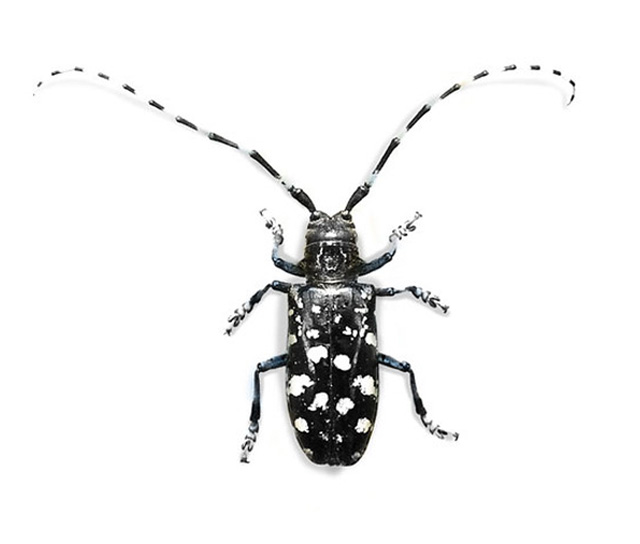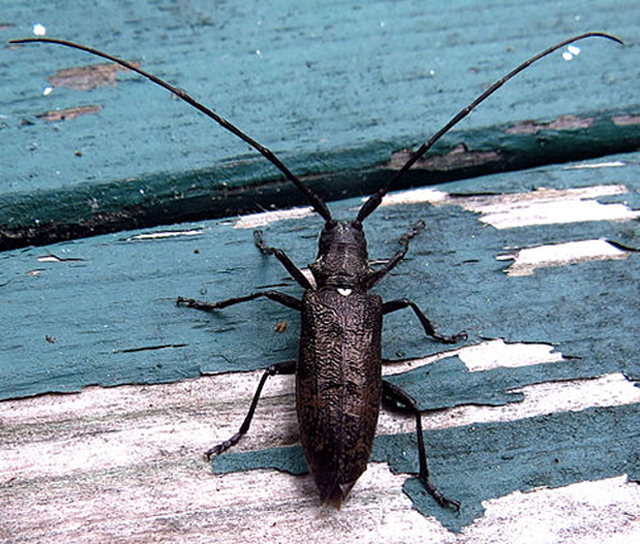Background
Asian long-horned beetle (ALHB) is an invasive forest pest with no natural enemies in North America that attacks nearly all broadleaf trees, with native Maples being the preferred host. It was introduced to North America in the 1990’s through untreated wooden shipping pallets. Adults lay their eggs in hardwood trees, and larvae then tunnel through the living tissue of the tree stopping the flow of water and nutrients, killing it. There have been very few sightings of ALHB in Ontario and it is important to be on the lookout for this dangerous invader. Several native non-harmful beetles can be easily confused with ALHB, so take a close look at how to identify this beetle listed below.
Range
Asian long-horned beetle is native to China and Korea where it is considered a major pest causing mortality of elm, maple, poplar and willow trees. Since arriving in the US, populations have been confirmed in New York, Illinois, New Jersey, and Ohio. In Canada, ALHB was confirmed in an industrial park in the Toronto area in September 2003. By November 2003 susceptible host trees were being removed from the area to eliminate possible ALHB habitat. ALHB was not found anywhere in Ontario between 2007 and 2012, indicating that early detection and rapid response was effective. In December 2013, ALHB was detected again near Pearson International Airport.
The Canadian Food Inspection Agency (CFIA) has established a regulated area in Mississauga and Toronto as part of its plans to eliminate the pest.
The Agency is cooperating with other authorities including the City of Mississauga, the City of Toronto, and the City of Brampton, as well as, the Ontario Ministry of Natural Resources and Forestry and Natural Resources Canada to determine next steps.
The regulated area includes the region bordered in the north by Finch, in the east by Martin Grove: in the south by Highway 401 and in the west Dixie; an area of approximately 20 square kilometres.
With the regulation of this area, there are now restrictions on the movement of nursery stock, trees, logs, lumber, wood, wood chips and bark chips from certain deciduous trees identified as hosts of the ALHB, and firewood of all species. Unless authorized by a Movement Certificate issued by the CFIA, the movement of these items out of the regulated area is prohibited. These restrictions are necessary to prevent the spread of the ALHB. Moving firewood or other restricted wood products, even just a few kilometres, is a common way for invasive insects and diseases to spread.
Impacts of Asian Long-horned Beetle
- Insecticides do not protect trees; trees must be cut down and burnt or chipped.
- Easily transported in firewood, live trees or untreated lumber.
- Potential decline in hardwood (broadleaf) trees could have major consequences for Ontario’s wildlife and biodiversity, negatively affecting future generations.
How to Identify Asian Long-horned Beetle
- Adults are 2 – 4cm (¾ – 1½ inches) in length.
- Shiny black with prominent, irregular white spots.
- Distinct bluish-white legs.
- Long, black and white banded antennae, one to two times its body length.
- Adults leave a round exit hole, approximately 1 cm across (slightly smaller than a dime) in trees.
INVASIVE
Asian Long-horned Beetle
(Anoplophora glabripennis)
Details
- Adults are 2 – 4 cm in length.
- Shiny black with prominent, irregular white spots.
- Distinct bluish-white legs.
- Long, black and white banded antennae, one to two times its body length.
- Adults leave a round exit hole, approximately 1 cm across in trees.
- Generally found on broadleaf trees
NATIVE
Whitespotted sawyer
(Monochamus scutellatus)
Details
- Adults are 1 – 3 cm in length.
- Black with distinct white spot behind head.
- Strong, long, reddish legs.
- Long, black antennae, one to two times its body length.
- Can have small, irregular white spots on its back.
- Generally found on conifers.
What You Can Do
- Learn how to identify adult Asian long-horned beetle and what infested trees look like, as well as which host trees they target.
- Don’t move firewood or other potentially infested wood material over long distances. With firewood, remember: burn it where you buy it!
- If you see an Asian Long-horned Beetle or signs of infestation, call the Ontario Ministry of Natural Resources at 1-800-667-1940 or the Canadian Food Inspection Agency at 1-800-442-2342.
- Report sightings to the toll-free Invading Species Hotline at 1-800-563-7711 or visit EDDMapS to report a sighting.
Gallery
OFAH/MNR Invading Species Awareness Program. (2021). Asian Long-horned Beetle. Retrieved from: www.invadingspecies.com.
This factsheet may be reproduced for non-commercial purposes.
Header photo by David Copplestone, MNRF.



